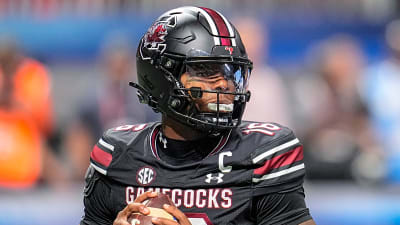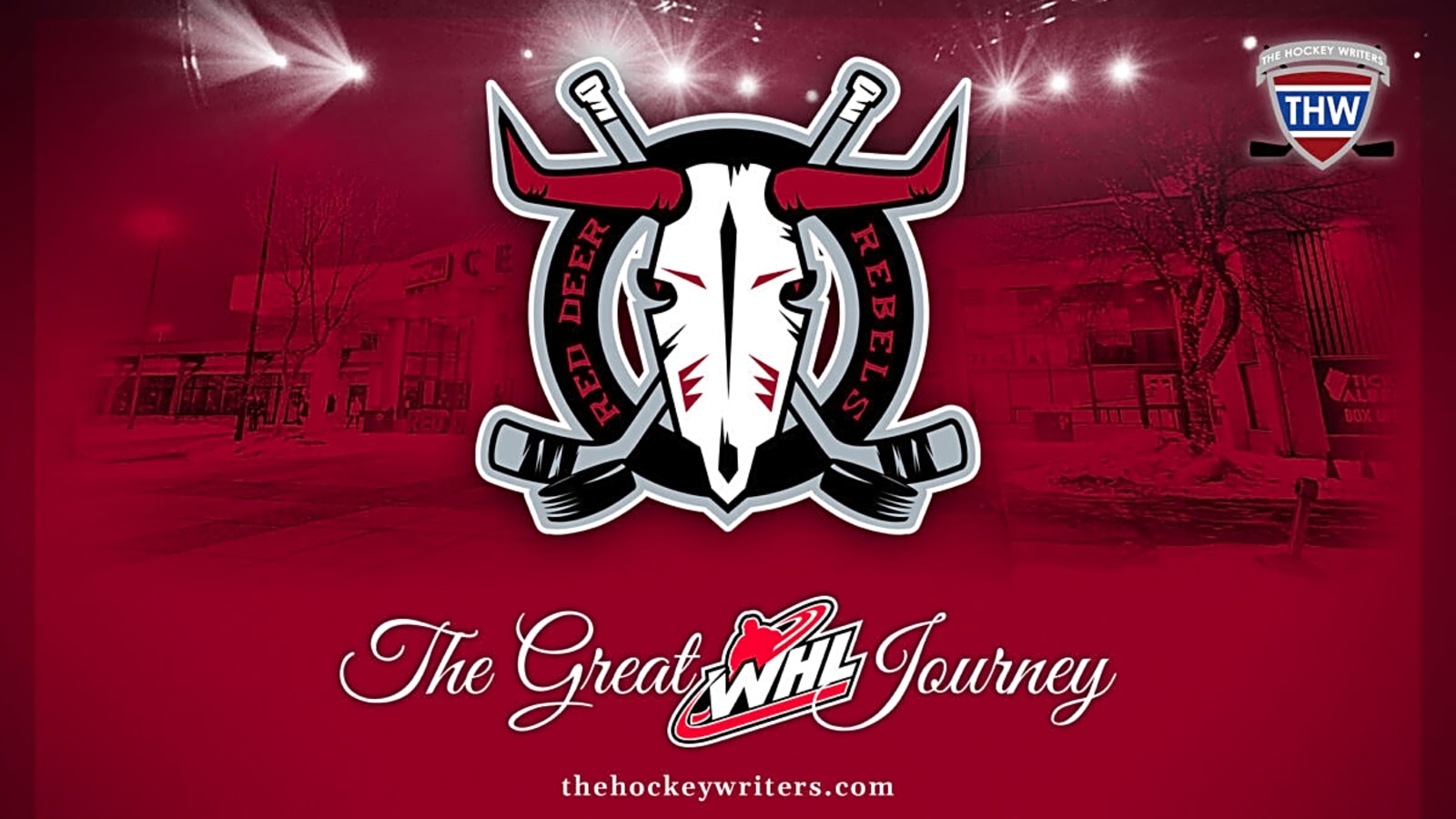
I’m a pretty simple hockey fan. My favourite in-game snack is poutine or just plain fries, which I can get at almost every arena in Canada. I like arriving early to watch warmups and leaving late to see the three stars. And, while I have a few areas I especially like to sit in, I’ll take any available seat as long as it has a decent view of the ice. I just like watching hockey.
I’ve approached most of my journey to see every Western Hockey League (WHL) team play in their home arena with that mentality. Hockey is the primary product, so everything in the arena should help make that shine. I don’t need a lot of fancy extras to enjoy the sport more; one of my favourite stops is still Prince Albert, one of the oldest arenas in the league, which can barely fit 3,000 people in a sell-out and operates a single concession stand. It’s a barn and I love it.
But, every now and then, it’s nice to be a little fancy. Despite my simple prerequisites, it’s hard to turn away softer seats, catered food, and a private space away from the crowds. The hockey may not be better, but the experience surely is. That’s exactly what was in my aunt and uncle’s minds when I asked them about coming to visit them and see a Red Deer Rebels game.
Rebels History
Red Deer’s hockey roots run incredibly deep, with organized hockey dating back to 1902, three years before Alberta entered Confederation. Yet the city has rarely been given the same respect as its larger neighbours to the north and south, even by its own province.
The issue began after the Western Canada Junior Hockey League (WCJHL) folded in 1956. For most teams, they returned to more local junior leagues, but for Bill Hunter and the Edmonton Oil Kings, they needed stronger competition. So, the junior Oil Kings were given a special exemption to play against several central Alberta senior teams in the newly created Central Alberta Hockey League (CAHL). The amalgamated league only lasted until 1966, but it helped the Oil Kings cement themselves as junior hockey icons, winning Memorial Cups in 1963 and 1966. But, just like before, the CAHL folded, once again leaving Edmonton without a league. This time, however, Hunter returned to his former opponents in the WCJHL and asked if they wanted to create a new major junior-level league with him, which they happily accepted, creating the first iteration of the WHL.
However, the folding of the CAHL didn’t just affect Edmonton; the Red Deer Rustlers, who joined the Oil Kings in the league’s inaugural season and remained all 10 years, were also without a place to play. After struggling for a year to find a new senior league, the Rustlers turned to the WHL in 1967-68 to see if they could join as a junior team. After all, the Oil Kings got an exemption. Why shouldn’t the Rustlers?
Unfortunately, the Alberta Amateur Hockey Association (AAHA) didn’t see it that way and blocked the transfer, ordering the Rustlers to join the lower-level Alberta Junior Hockey League (AJHL) instead. The Rustlers were rightfully furious at the decision and initially refused to accept the order to play and suspend operations. But the governing body didn’t waver on their ruling, and after two seasons, the Rustlers relented, but not without a chip on their shoulder. They won the league championship in their first season, defended the title successfully in 1970-71 while also taking home the Centennial Cup as the best Junior A team in Canada, and again in 1971-72 before losing it in the 1972-73 Final, but retook it in 1973-74.
A key player in that 1974 title was Brian Sutter, who not only went on to have an illustrious NHL career both as a player and coach but also ushered in a new generation of talent for the Rustlers. Darryl followed him from Viking, Alberta, to Red Deer in 1974-75, Duane in 1976-77, Brent in 1977-78, and twins Ron and Rich in 1979-80. It was that final season of Sutter’s that the team became truly unstoppable. Brent led the team with 70 goals and 171 points in 59 games, leading the Rustlers to yet another AJHL title and Centennial Cup and becoming the first Junior A player to be selected in the first round of the NHL Draft, going 17th overall in 1980 to the New York Islanders.
“That team lost only nine games during the regular season and only a couple in the playoffs . . . we were good enough that we could have competed with any major junior team.”
Brent Sutter on playing with the Rustlers (Red Deer Advocate)
But, because the Rustlers were still a Junior B team, they struggled with retaining players and, thus, making money. Ron and Rich Sutter only stayed for a single season before leaving to join the rest of their siblings with the WHL’s Lethbridge Broncos. At one point, shares were sold to some former players to keep the team afloat. “I really enjoyed the coaching part of it,” Wynne Dempster said, who joined the Rustlers in 1980-81. “But the hard work was trying to generate enough money to get paid. There were stretches when it was tough to make sure you got a paycheque.”
Following another AJHL title in 1985, the Rustlers took a leave of absence to sort out their financial issues, returning a year later under new private ownership. They won again in 1987, but took another leave midway through the next season after players refused to take a cut in their honoraria. Then, in 1989, the Rustlers were expelled from the AJHL for violating the league’s bylaws, which seemed like the end for hockey in Red Deer. Yet an olive branch was extended from Terry Simpson, the longtime coach of the Prince Albert Raiders, who had successfully moved from the Saskatchewan Junior Hockey League (SJHL) to the WHL in 1982-83. He knew how to build a profitable team in a small market, so he approached WHL President Ed Chynoweth about putting a WHL team in Red Deer.
The league was interested. The Rustlers were a premier AJHL team, but Red Deer didn’t have a WHL arena. If they had that, then the WHL would consider the application. Two years later, the Red Deer Centrium was opened, but instead of bringing over the Rustlers, the struggling team was finally folded in 1992 and replaced with the Red Deer Rebels. The name was chosen from a fan vote, and while ‘Centurions’ was a popular choice because it sounded like the new arena name, management preferred the more Western-sounding Rebels, adopting a black and silver colour scheme. In the team’s first game on Sept. 25, 1992, they beat Simpson’s former Raiders 6-3.
In 1999-00, Simpson sold the franchise to Brent Sutter, who had just retired from a fruitful NHL career. The former Rustler loved the opportunity, but barely had enough money to afford the team and put his farm up for collateral while naming himself head coach and general manager because he couldn’t afford to hire anyone else. But he came with plenty of confidence, declaring that the Rebels would win the Memorial Cup in three years. His timeline was a little off; it only took the Rebels two seasons.
They dominated the best the Western Hockey League had to offer before dispatching the three best junior teams in the country, including a 6-5 overtime win in the Memorial Cup final over the Val-d’Or Foreurs.
— Hockey Alberta (@HockeyAlberta) July 21, 2024
Welcome to the Alberta Hockey Hall of Fame, 2000-01 Red Deer Rebels!… pic.twitter.com/rVNmlWVCmt
Since their Memorial Cup title, the Rebels have only missed the playoffs four times and have one of the most dedicated fan bases in the league. In 2024-25, despite missing the playoffs, they had the 10th highest average in the league. Meanwhile, Edmonton and Calgary struggled with fan support and lost several junior teams before getting the Calgary Hitmen in 1995 and the Oil Kings 2.0 in 2007. Red Deer had its fair share of struggles, but it deserves a place in hockey history alongside their much larger cousins.
Franchise Leaders:
- Most Points (Total): Aaron Asham (1994-98) – 292
- Most Points (Season): Justin Mapletoft (2000-01) – 120
- Most Goals (Season): B.J. Young (1996-97) – 58
- Most Games Played: Jonathan Zukiwsky (1993-98) – 301
- Most Wins (Total): Cam Ward (2000-04) – 102
- Most Wins (Season): Darcy Kuemper (2010-11) – 45
- Honoured Numbers: None, but several honoured players with banners hanging in the arena’s foyer
- Highest Drafted Players: Ryan Nugent-Hopkins, 1st (Edmonton Oilers, 2011); Haydn Fleury, 7th (Carolina Hurricanes, 2014); Matt Dumba, 7th (Minnesota Wild, 2012); Dion Phaneuf, 9th (Calgary Flames, 2003)
The Centrium
In 1990, the Rustlers were playing out of the Red Deer Arena, which had been around since 1952 and had a max capacity of just 1,360 fans. That was already small in 1967, with the Saskatoon Arena sitting over 3,000, the Edmonton Gardens sitting 5,200 fans, and Calgary’s Stampede Corral housing a whopping 7,475 people. Its replacement was the Red Deer Centrium, opening in 1991 with a max game-day seating of 6,623 fans, a much more fitting home for a premier WHL franchise.
The name ‘Centrium’ comes from the portmanteau of centennial, Central Alberta, and coliseum, based on its design style. The strange name has made it somewhat of an icon, and despite several sponsorship changes, it’s always kept that moniker. The first arrived in 1999 with ENMAX, which lasted a decade before returning to the Westerner Park venue. In 2021, Red Deer-based retail chain Peavey Mart signed a five-year deal to be the title sponsor, but on Feb. 5, 2025, just days before we arrived, the partnership was dissolved due to financial issues. A new sponsor was unveiled in June 2025, but on our trip, the building was simply the Centrium despite the Peavey Mart signs outside.
Unlike Lethbridge or Moose Jaw, Red Deer’s Centrium has a muted external profile, resembling a strip mall with various offices and businesses sharing its space. However, the outside is a mirage. Inside, the place felt incredibly roomy with an expansive foyer that easily fit the crowds entering the building. People are filed up a short set of stairs into the main arena, where they enter the main concourse that is equally spacious while still giving fans a great view of the ice. It was as good or better than walking around Saskatoon’s arena, which I later learned was because the Centrium was modelled after SaskTel Centre.
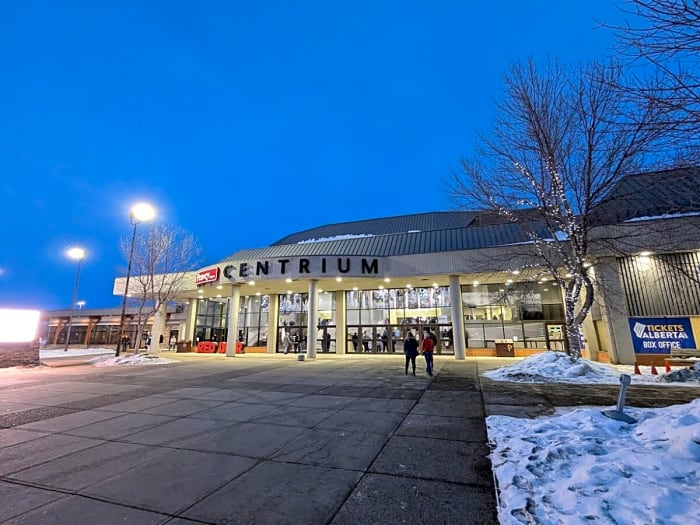
Everything in the Centrium was eye-catching, but I was most impressed with the view. The slope from the concourse to ice level is less intense than the SaskTel Centre, making it feel like you’re almost against the glass despite standing at the top row of the lower level. The upper bowl was a bit steeper, but my aunt confirmed that, just like in Saskatoon, there isn’t a bad seat in the house.
Part of that is due to extensive renovations to the Centrium to prepare for the 2021 World Junior Championship, which included a new score clock, LED boards, new dressing rooms, and luxury suites. Those suites came in handy during the shortened 2020-21 season, as the team used those rooms instead of relying on billets to mitigate potential health concerns.
“We just viewed this as the best option in our mind. They can socialize with their teammates, which would be more challenging to do outside of this. If you’re another team, once you leave your rink, if you’re following the protocols you’re not able to do much and you’re not even supposed to be going from billet to billet. It’s basically only the people at the billet house allowed in that house.”
Merrick Sutter, Red Deer Rebels vice president and alternate governor (from “The hockey suite life: A look inside as 25 Red Deer Rebels players bunk at the arena,” The Athletic – 2/18/21)
As for the old Red Deer Arena, it was demolished in 2016 to make room for the Servus Arena, a new state-of-the-art recreational facility, but it made sure to honour its roots. The original Red Deer Arena’s neon sign was kept and is now displayed in the Servus Arena’s lobby, and public art displays have paid homage to it. Even the seating pays tribute to the old arena with a maximum capacity of 1,360 people.
Food and Extras
Summary
- Tickets – $29.50 (Tickets Alberta)
- Hat – $35-48
- Jersey – $140 ($350 with a nameplate)
- Puck – $6
The Centrium offers similar fares to other arenas in the league. The souvenir shop was well-stocked with pucks, apparel, jerseys, and various trinkets, and the concession stands offered pizza, burgers, fries, and other staple arena foods. However, a few notable differences separated Red Deer from its competition.
In my opinion, the Rebels offered more unique souvenirs than any other team I’ve seen thus far. I very nearly picked up their ugly Christmas sweater jersey hanging on the discount rack and a car brush made from a game-used Rebels hockey stick. My wife then asked me if I was going to carry that around for the rest of the game, which finally dissuaded me from picking one up. Instead, I went with some very soft socks with the Rebels logo, which I believe is one of the best in the WHL, and a pack of team-issued hockey cards. I learned later that the team used to offer packs of signed cards for $5-10 more, which would have been very cool if they were available. I was able to grab a couple of autographs after the game, though, which was still a fun opportunity.
There was also a BBQ area at the back of the concourse that sold chicken wings, ribs, pulled pork, and even brisket sandwiches, which you could eat at their faux patio set up to the side. At the regular concession stands, Anthony’s Pizza was a more artisanal alternative to the typical arena pizza slice and looked like it was fired in a pizza oven instead of left on a warming rack. And, of course, I couldn’t go to the Centrium without trying their soft serve swirl ice cream, which they claim is the best in the WHL. Although I’m generally not an ice-cream-at-hockey-games guy, it was an excellent third-period snack.
For the regular fan, there were a ton of options to turn a typical hockey game into a special experience. But, for a couple of hours on Feb. 21, 2025, I wasn’t a typical fan. Instead, I watched the game from the Centrium’s premier luxury suite, giving me an experience like I’ve never had before.
Feb. 21, 2025 – Red Deer Rebels vs. Saskatoon Blades
My first distinct memory of attending a hockey game was in Red Deer with my uncle Ron. Although my dad and uncle had taken me to Medicine Hat Tigers’ games since I started walking, I can’t remember anything from those trips. With Ron, though, I remember sitting in the corner right at ice level and the boom from a big check into the boards. I also vaguely recall the bright green seats surrounding the ice and the tiny souvenir stand, where my uncle got me a Rebels flag, which I’ve kept with me to this day.
So, when formulating my idea to see a game in every WHL arena, Ron was one of the first people I thought of connecting with during my journey. In my mind, it was a way to pay him back for all the amazing trips he’d taken me on throughout the years. After the Rebels game in the late 1990s, he took me to my first NHL game in 2003 in Calgary, then invited me to join him to see the New Jersey Devils, my favourite team, play the Edmonton Oilers. A few years later, I joined him in Edmonton at the Oilers Sportsnet Club, which was the most extravagant viewing experience I’ve ever had at a hockey game. There was no way I could ever pay him back, but I wanted to show my appreciation by dedicating a trip especially to see a game with him.
However, Ron had different plans. He’d read all my previous articles detailing my journey and wanted to give me something special to write about, so he surprised my wife and me with two tickets to the ATB Financial luxury suite. My aunt, who has been in journalism for many years, got in on the fun and surprised me by connecting with Troy Gillard, the Rebels’ play-by-play announcer, whom she knew from a few passing interactions.
I was floored. Here I was, thinking that my little journey would be a small affair, yet my aunt and uncle had turned it into a massive experience. However, I maybe should have seen this coming, as they love amplifying special moments by making them a little fancy. When I graduated from high school, they offered to take me on a trip of my choice, so that summer, the three of us went to San Francisco for several days, an offer they extended to my younger brother and cousin two years later. It’s hardly surprising that they would go the extra mile to make this hockey game special.
Once we entered the arena, we took a right turn at the top of the stairs, where we met an attendant and a few others who were joining us in the suite. Ron introduced us to all of them, many of whom he worked with, and after every introduction, he told them I’d be publishing an article about the game and that they had to read it. After a few minutes, we were allowed onto the elevator, which whisked us to a quiet hallway on the top floor lined with luxury suites. I peeked in the open doors as we passed the suites en route to ours, eager to get an idea of what to expect, yet none of them compared to our suite. Not only was it much larger than the typical box, but it was outfitted with a living room area and a big buffet table, ready for the food to be delivered.
There, we met our host and ATB Financial connection, Kolson Moore. He, too (after my uncles’ advertising), was eager to hear about my WHL journey and whether Red Deer would top the rankings as the best stop. We chatted for a bit about how he became a hockey fan, as he grew up close by the city, then it was nearly time for puck drop, so I took my seat and readied myself for an experience like no other.
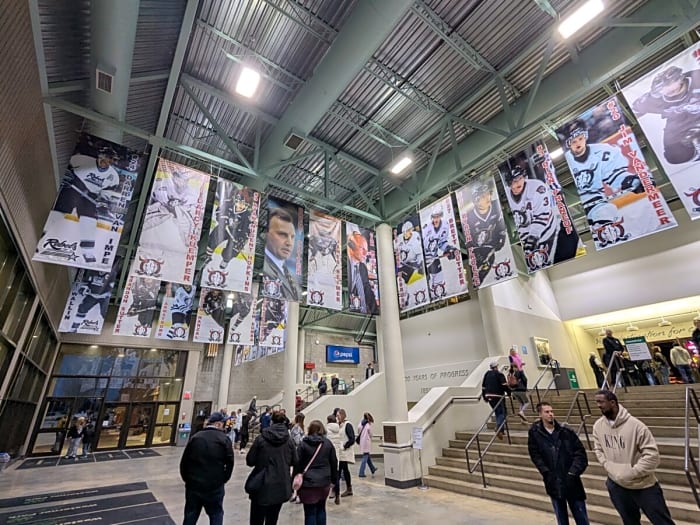
While I always want to cheer for the home team on my journeys, Saskatoon made that difficult by jumping to a 1-0 lead near the end of the first. The two teams have developed a bit of a rivalry over the past few seasons, highlighted by an incredible reverse sweep in the 2024 WHL Playoffs, but the Rebels lost a lot of their veterans from that team and were in a bit of a rebuild. The Blades were also a younger team, but in this matchup, Saskatoon looked far and away the better team. However, Rebels forward Ollie Josephson showed off his blazing speed at every opportunity, and goalie Chase Wutzke made some big saves to keep his team in the game.
No goals were scored for the next 33 minutes, but the Rebels were ramping up their attack with gritty play and firing everything on net. However, Saskatoon were more dialled in and broke the scoring drought 12 minutes into the third, quieting an already sleepy crowd. But, with less than two minutes left and Red Deer’s net empty, Josephson fired the puck by the Blades’ goalie Ethan McCallum to get the Rebels within one, and less than a minute later, rookie winger Beckett Hamilton tied the game at two. All of a sudden, the crowd was very alive, as were the Rebels – we were going into overtime.
Overtime was a tense affair, with both teams getting chances, but their goalies keeping them alive. The game looked well on its way to a shootout when a scuffle at centre ice resulted in Blades rookie David Lewandowski holding a Rebel on the ice. That gave him the jump, and while his opponent recovered, the Blades had a 3-on-2, leading to the game-winning goal. The crowd erupted in boos, which the Blades ate up, especially Lewandowski (who was named the first star) and alternate captain Tyler Parr, who was also involved in the centre ice scrum that led to the goal. While I like seeing my Blades win, I thought the Rebels deserved a chance at the shootout, especially after their heroic effort to tie the game. It’s always more fun to see the home team win.
Despite the semi-disappointing result, the experience from the suite was like no other. While I’m more than happy with some salty fries, we had the option of dining on nachos, pizza, ribs, chicken wings, sausage, pierogies, dry ribs, and mac and cheese bites, which were both my wife’s and my favourite. There was even a fridge with unlimited drinks, which I unfortunately forgot about once the game started. I could grab a snack in between plays, chat with people without having to shout over the crowd, and get up and stretch whenever I wanted without disturbing anyone around me. My wife especially appreciated that she didn’t have to focus on hockey the whole time and tuned into the curling bonspiel on the TV screens throughout the game. I don’t need all that to be happy, but it’s fun to be a little fancy sometimes.
Yet the fancy suite was so much fun because I shared it with people I love. That makes every game special, and I was surprised to find that’s exactly how Troy felt. He’s been the Rebels’ play-by-play announcer since 2021, taking over from longtime announcer Cam Moon, who joined the Oilers‘ broadcast team. Before that, he was involved in a variety of jobs with the team, serving as part of Red Deer’s broadcast crew since 2011, including working as the Rebels’ pregame and intermission host and the public address announcer. You’d think that moments would blend together, but each one remains special.
“I only ever got to go to one game a year, so it was always kind of an event,” Troy said about his earliest memories of the team. “Growing up, it was usually right around my birthday, so I had a few birthday parties here, which were a lot of fun over the years. But one thing that has always stood out to me is just how much of an event Rebels games are, win, lose, or back in the day, tie. Just the atmosphere here at the Centrium. Admittedly, I’m biased, but it’s pretty hard to match, especially when you get the really big crowds in this building. Great action on the ice, combined with just the tremendous loyalty of the fans and the excitement and the knowledge they have, just makes for a really tremendous atmosphere.”
Several players made those games special, starting when Darren van Impe first came to the Rebels from the Prince Albert Raiders and emerged as Red Deer’s first real superstar. There were also plenty of local kids who were fun to cheer for, like Dean Tiltgen, who became the franchise’s first 50-goal scorer, and Jon Zukiwsky, the franchise’s leader in games played. The Rebels also had their version of the Sutter brothers with Pete, Jim, and Ted Vandermeer. When Troy began working with the team, he got to know Ryan Nugent-Hopkins, who came in as a 15-year-old, as well as Matthew Dumba, Arshdeep Bains, Ben King, and Kai Uchacz.
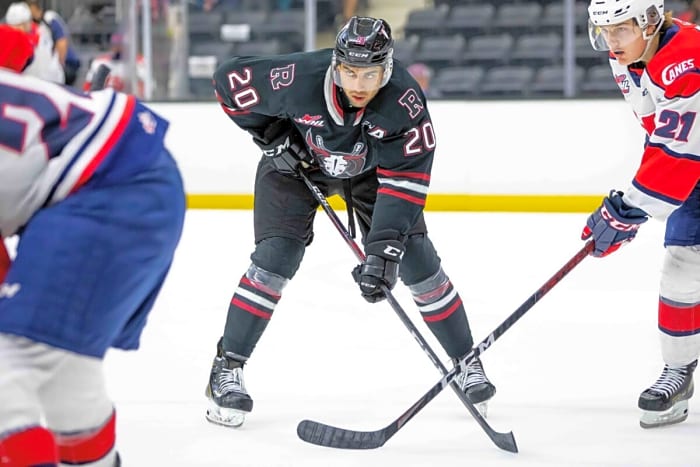
But, as he got more professionally involved with the team, he found that every game was special, even if there weren’t any big-name stars on the roster. The intensity from the players on the ice to the people in the stands was enough to turn any mundane game into an event.
“I think a lot of it comes back to the passion of the fans because they know that these guys are only going to be here for two, three, four, or sometimes if you’re lucky, you get to watch guys play for five years in junior, and each of these players have a different path ahead of them. Yeah, we’ve talked about the guys that go on to long, fruitful NHL careers, and that’s really awesome, but then you also get these guys that have worked their tails off in the WHL, go off to play university or college hockey for three or four more years, and then go on to lengthy professions, and they’re doing well for themselves that way. And then you get to know other guys who you just never quite know where their journeys are going. I love the unique stories that come with being around a junior hockey club. All of those things meshing together is what keeps me coming back.”
Much of Troy’s journey mirrors my own experience. As a kid, going to games was rare, and each one became a special occasion. As I became a bigger hockey fan and cheered for NHL teams, watching junior games still felt more special because it was a window into someone’s journey to making their dream come true. After following the Blades as a journalist in 2024-25, that feeling was only amplified; I went to more games than ever before, and each one still felt more special than the last. I had been allowed to do my dream job, just like Troy, which made each mundane moment special.
I don’t get to see my aunt and uncle as much as I used to. Saskatoon is much farther away from Red Deer than my parents’ farm, and it’s tougher to find time away from work to do fun things like see hockey games with family and friends. But, just like Troy and I, my aunt and uncle know that every moment is special and worth celebrating. Even the mundane trips are worth making fancy because every moment is worthy of that reverence.
My uncle has had his share of special moments with the Rebels. He volunteered to work security at the Centrium for the 1995 World Junior Championship, where he was stationed outside Team Canada’s dressing room and saw the Canadians take home their eighth title from ice level. He watched future NHL stars like Aaron Asham and Dion Phaneuf tear up the WHL, but his favourite Rebel of all time was Justin Mapletoft, who was a big part of the team’s Memorial Cup win.
On this date in 2000, the Rebels defeated the Kootenay Ice 7-2, Justin Mapletoft scored 2 goals and 2 assists to lead the way. The 5,735 seat Westerner Park Centrium had 6,250 stuffed in there. #RDR pic.twitter.com/UqtxWBnmnw
— Red Deer Rebels (@Rebelshockey) October 20, 2020
I think that reveals a lot about my uncle. Although Mapletoft was a great junior, he never became an NHL star, playing just 38 games with the Islanders from 2002-04. But in Red Deer, he was the team’s biggest scorer when it mattered the most. Some may see the WHL as unimportant, especially with so many players leaving to play college hockey, but for the fans of those markets, it’s incredibly important. Even if they don’t go on to hockey greatness, each moment is worth celebrating for those players. Thanks to them, as well as Kolson at ATB Financial and all the other people in the suite, my little moment was given the same level of extravagance, despite feeling like it didn’t deserve it. And that’s what truly made it a special experience – the people who made it happen.
One common question I got during the game was whether Red Deer would get the best grade on my journey. I never intended to rate arenas and experiences beside each other, especially when each one is so unique and special in its own way, so I often gave non-committal answers, complimenting several places I’ve been on my trip.
But if it were a competition, Red Deer would win. Sometimes, it’s more fun to be fancy.
More must-reads:
- Canucks believed to have inquired about Predators' Steven Stamkos
- Week 9 fantasy football takeaways: Rico Dowdle makes a statement
- The 'TDs from Josh Allen or Patrick Mahomes' quiz
Breaking News
Trending News
Customize Your Newsletter
 +
+
Get the latest news and rumors, customized to your favorite sports and teams. Emailed daily. Always free!







